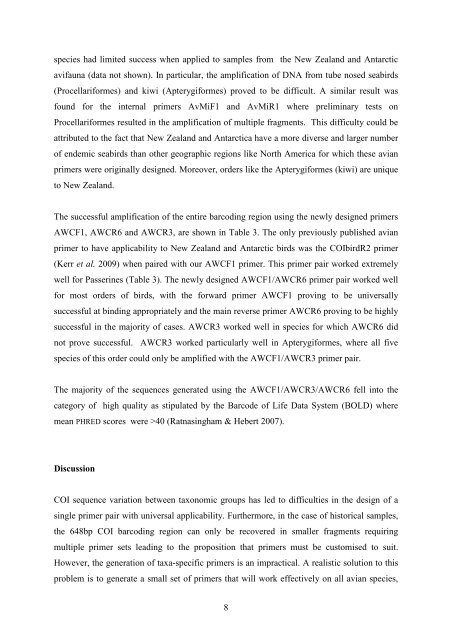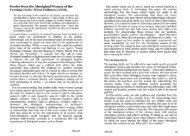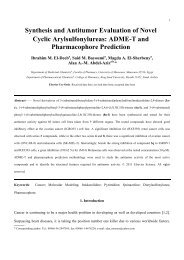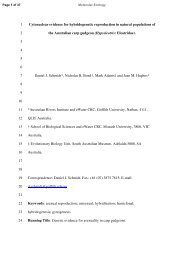Universal Primers for DNA barcoding of all Avian Species - Griffith ...
Universal Primers for DNA barcoding of all Avian Species - Griffith ...
Universal Primers for DNA barcoding of all Avian Species - Griffith ...
Create successful ePaper yourself
Turn your PDF publications into a flip-book with our unique Google optimized e-Paper software.
species had limited success when applied to samples from the New Zealand and Antarctic<br />
avifauna (data not shown). In particular, the amplification <strong>of</strong> <strong>DNA</strong> from tube nosed seabirds<br />
(Procellari<strong>for</strong>mes) and kiwi (Apterygi<strong>for</strong>mes) proved to be difficult. A similar result was<br />
found <strong>for</strong> the internal primers AvMiF1 and AvMiR1 where preliminary tests on<br />
Procellari<strong>for</strong>mes resulted in the amplification <strong>of</strong> multiple fragments. This difficulty could be<br />
attributed to the fact that New Zealand and Antarctica have a more diverse and larger number<br />
<strong>of</strong> endemic seabirds than other geographic regions like North America <strong>for</strong> which these avian<br />
primers were origin<strong>all</strong>y designed. Moreover, orders like the Apterygi<strong>for</strong>mes (kiwi) are unique<br />
to New Zealand.<br />
The successful amplification <strong>of</strong> the entire <strong>barcoding</strong> region using the newly designed primers<br />
AWCF1, AWCR6 and AWCR3, are shown in Table 3. The only previously published avian<br />
primer to have applicability to New Zealand and Antarctic birds was the COIbirdR2 primer<br />
(Kerr et al. 2009) when paired with our AWCF1 primer. This primer pair worked extremely<br />
well <strong>for</strong> Passerines (Table 3). The newly designed AWCF1/AWCR6 primer pair worked well<br />
<strong>for</strong> most orders <strong>of</strong> birds, with the <strong>for</strong>ward primer AWCF1 proving to be univers<strong>all</strong>y<br />
successful at binding appropriately and the main reverse primer AWCR6 proving to be highly<br />
successful in the majority <strong>of</strong> cases. AWCR3 worked well in species <strong>for</strong> which AWCR6 did<br />
not prove successful. AWCR3 worked particularly well in Apterygi<strong>for</strong>mes, where <strong>all</strong> five<br />
species <strong>of</strong> this order could only be amplified with the AWCF1/AWCR3 primer pair.<br />
The majority <strong>of</strong> the sequences generated using the AWCF1/AWCR3/AWCR6 fell into the<br />
category <strong>of</strong> high quality as stipulated by the Barcode <strong>of</strong> Life Data System (BOLD) where<br />
mean PHRED scores were >40 (Ratnasingham & Hebert 2007).<br />
Discussion<br />
COI sequence variation between taxonomic groups has led to difficulties in the design <strong>of</strong> a<br />
single primer pair with universal applicability. Furthermore, in the case <strong>of</strong> historical samples,<br />
the 648bp COI <strong>barcoding</strong> region can only be recovered in sm<strong>all</strong>er fragments requiring<br />
multiple primer sets leading to the proposition that primers must be customised to suit.<br />
However, the generation <strong>of</strong> taxa-specific primers is an impractical. A realistic solution to this<br />
problem is to generate a sm<strong>all</strong> set <strong>of</strong> primers that will work effectively on <strong>all</strong> avian species,<br />
8





